“The only way to discover the limits of the possible is to go beyond them into the impossible.” – Arthur C. Clarke. This quote perfectly captures the essence of how technology is reshaping industries. Companies are leveraging advanced tools to create groundbreaking experiences. One such innovation is the integration of intelligent systems into creative processes.
From streaming platforms like Netflix to giants like Amazon Prime, these systems are transforming how content is produced and consumed. Market projections indicate significant growth, with the sector expected to reach $44.08 billion by 2028, growing at a CAGR of 25.7%1. This shift highlights the increasing reliance on data-driven solutions to meet consumer demands.
Personalization and efficiency are at the forefront of this evolution. Consumers now expect tailored experiences, and intelligent systems are delivering just that. By analyzing viewing habits, these tools enhance recommendations, making it easier to find relevant content2. This not only improves user satisfaction but also drives engagement and loyalty.
Key Takeaways
- Market size projected to grow to $44.08 billion by 20281.
- Streaming platforms like Netflix are leading the way in AI integration.
- Personalized recommendations enhance user experiences2.
- Data-driven strategies improve audience engagement and loyalty.
- AI-driven content creation reduces costs and time to market1.
Introduction to AI in Entertainment and Media
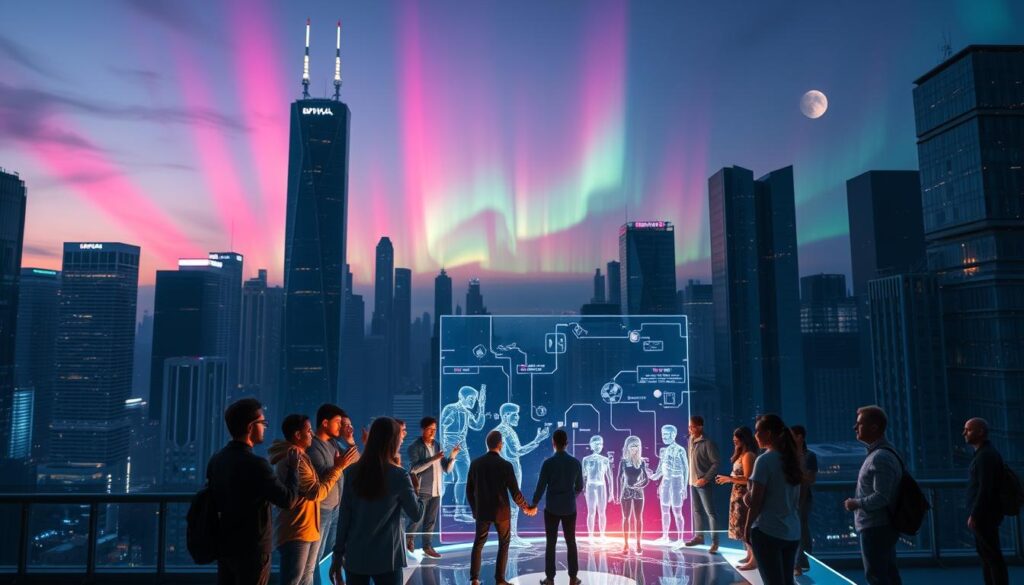
From scriptwriting to audience targeting, intelligent systems are redefining media production. These tools have evolved from basic automation to sophisticated solutions that streamline creative workflows and enhance service delivery3.
Overview of Evolution
Early systems focused on simple tasks like data analysis. Today, they handle complex processes such as video editing and audience segmentation. For example, Warner Bros. uses the Cinelytic platform for box office predictions, while Sony Pictures leverages ScriptBook for revenue forecasting3.
This evolution has transformed how content is created and distributed. Real-time translation and subtitling powered by intelligent tools make media accessible to global audiences4. These advancements highlight the growing role of technology in shaping the industry.
Importance in Today’s Industry
Intelligent systems are now essential for delivering personalized experiences. Platforms like Spotify use algorithms to create tailored playlists, boosting user engagement3. Similarly, automated tools in marketing enable precise audience targeting, optimizing promotional efforts4.
These technologies also streamline production workflows, reducing costs and time to market. By automating repetitive tasks, they free up resources for creative development4. This shift benefits creators, marketers, and audiences alike, driving innovation across the industry.
Transformative Impact of AI on Media and Entertainment

Personalized experiences are becoming the norm, thanks to cutting-edge tools. Streaming platforms like Netflix and Amazon Prime are leading this shift. They use machine learning to analyze viewing habits and deliver tailored recommendations5.
Personalized Content Experiences
28% of US individuals rely on personalized suggestions to discover their favorite shows and movies5. Intelligent systems analyze user behavior to curate content that matches individual preferences. This enhances the overall experience and keeps audiences engaged.
Platforms like Spotify use algorithms to create custom playlists. This not only boosts user satisfaction but also increases loyalty6. Personalized content is now a key driver in the industry.
Automation in Content Production
Automation is revolutionizing production workflows. Tools like Microsoft’s Azure AI Video Indexer generate detailed metadata, improving content indexing5. This reduces manual effort and speeds up processes.
AI-powered video editing tools analyze raw footage to identify key moments. They automatically apply transitions and effects, saving time and resources5. This technology is transforming how content is created.
For more insights on how AI in business is shaping industries, explore our detailed guide.
AI in Content Creation and Production Techniques
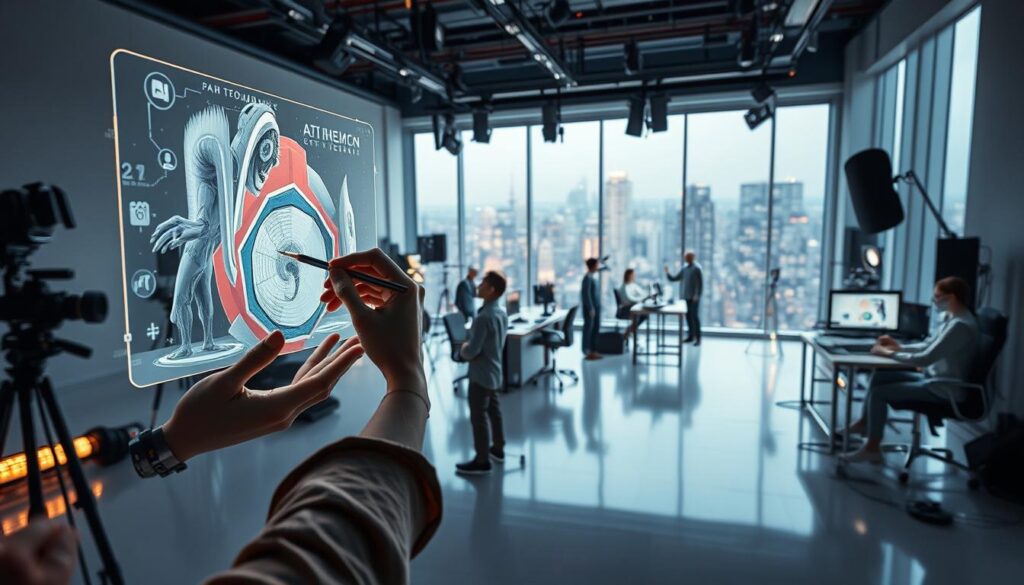
Creative workflows are being revolutionized by advanced tools that streamline content creation and production. These innovations are transforming how scripts are written, stories are visualized, and videos are edited. By leveraging data-driven solutions, creators can deliver high-quality content faster and more efficiently.
Innovative Scriptwriting and Storyboarding
Scriptwriting has entered a new era with tools like Sudowrite. These platforms use intelligence to analyze data and generate compelling narratives. Writers can focus on creativity while the agent handles repetitive tasks like grammar checks and plot consistency.
Storyboarding also benefits from these advancements. AI-driven tools can visualize scenes based on script inputs, saving time and effort. This approach ensures that the final product aligns with the creator’s vision7.
Automated Video Editing and Post-production
Video editing is now faster and more precise with platforms like Magisto. These tools use intelligence to analyze raw footage, identify key moments, and apply transitions automatically. This reduces manual intervention while maintaining high-quality output7.
Post-production workflows are also streamlined. Tasks like color correction and facial recognition are automated, minimizing errors and improving accuracy. This allows creators to focus on delivering exceptional content to their customer base8.
AI in Music and Audio Innovations
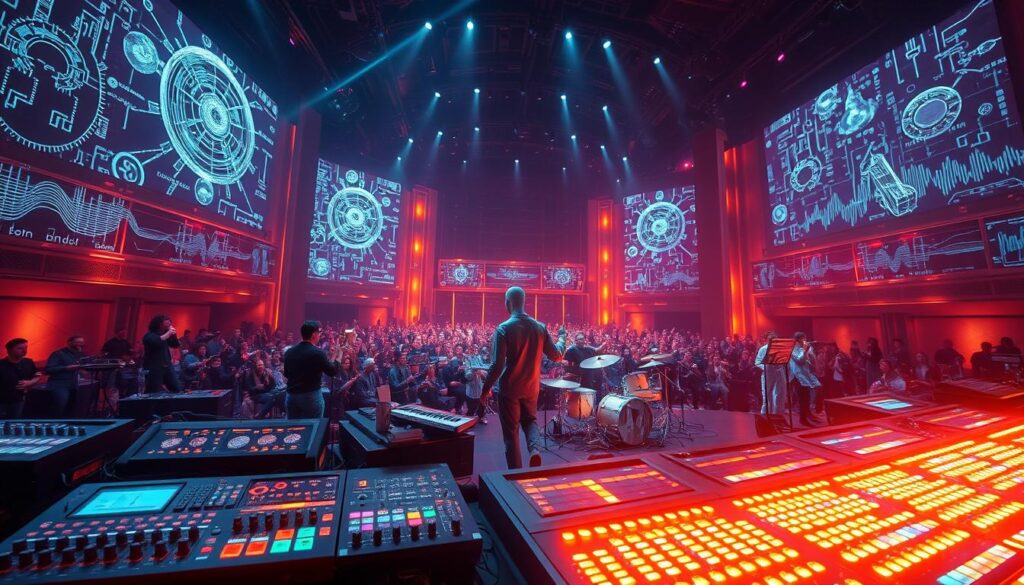
Music production is undergoing a transformation, driven by advanced systems that blend creativity with technology. These innovations are reshaping how melodies are composed and how sound is mastered, offering new possibilities for artists and producers alike.
AI-Generated Music Composition
Platforms like AIVA use deep learning to analyze vast datasets and create customizable soundtracks. This system allows musicians to generate new melodies, chord progressions, and lyrics efficiently9. For instance, The Beatles completed a new song after 45 years using AI tools that isolated John Lennon’s voice10.
Such advancements not only enhance creative efficiency but also open doors for experimentation. Artists can explore new genres and styles without the constraints of traditional methods10.
Enhancing Audio Quality with AI Tools
AI-powered platforms like LANDR are revolutionizing audio mastering. These tools optimize sound production, ensuring high-quality output for both professionals and amateurs10. They analyze audio files to apply precise adjustments, reducing the need for manual intervention.
For businesses, this translates to cost savings and faster turnaround times. By automating repetitive tasks, companies can focus on delivering exceptional audio experiences to their customer base9.
As technology continues to evolve, the convergence of art and innovation will redefine the music industry, offering endless possibilities for creators and listeners alike.
Enhancing Viewer Experience with AI-Driven Personalization

Interactive technologies are making content discovery more intuitive and engaging. By analyzing user behavior, these systems deliver tailored experiences that keep audiences hooked. Streaming services like Netflix and Spotify are leading the charge, using advanced tools to boost engagement and satisfaction11.
Customized Recommendations and Content Curation
Personalization engines analyze viewing habits to suggest relevant shows, movies, or playlists. For instance, Netflix’s algorithms improve user retention by up to 30%11. Similarly, Spotify’s curated playlists enhance loyalty by offering unique listening experiences. These solutions make content discovery faster and more enjoyable.
Platforms like Seven West Media’s 7plus use predictive models to re-engage inactive users. With a 93% accuracy rate in viewership predictions, they deliver content that resonates with audiences12. This approach ensures that users stay connected to the platform.
Voice Control and Interactive Interfaces
Voice-activated tools are transforming how users interact with media. Smart assistants like Alexa and Google Assistant allow seamless navigation through content libraries. This hands-free experience enhances accessibility and convenience.
Interactive interfaces also play a crucial role. Features like real-time sentiment analysis help creators understand audience preferences. This data-driven approach ensures that content aligns with viewer expectations, boosting engagement and satisfaction13.
Revolutionizing Gaming and Interactive Media with AI

Gaming experiences are being reshaped by intelligent systems that adapt to player behavior. These advancements are creating more immersive and engaging environments, pushing the boundaries of what’s possible in interactive media.
Adaptive Gameplay and Dynamic Difficulty
Intelligent systems now adjust game challenges in real-time based on player performance. Games like Left 4 Dead and Resident Evil 4 use adaptive difficulty to keep players engaged14. This approach ensures that the experience remains challenging yet enjoyable for all skill levels.
Procedural content generation, seen in titles like Minecraft and No Man’s Sky, enhances replayability. By algorithmically creating unique environments, these systems ensure no two playthroughs are alike14. This efficiency in content creation reduces development time while offering players endless possibilities.
Enhancing NPC Behavior and Storytelling
Non-player characters (NPCs) are becoming more lifelike with advanced systems. Projects like Stanford’s Smallville showcase social intelligence, enabling agents to build relationships and maintain memories15. This evolution makes interactions feel more realistic and engaging.
Games like AI Dungeon 2 use generated storylines to provide unique narratives. With 100,000 players within a week of its release, it highlights the demand for personalized storytelling16. These innovations improve management of narrative elements, offering players deeper immersion.
As these technologies evolve, they will continue to redefine gaming, making it more interactive, adaptive, and enjoyable for players worldwide.
Leveraging AI for Targeted Marketing and Advertising

Modern marketing is being reshaped by intelligent systems that deliver precision and efficiency. These tools are transforming how brands connect with their audiences, enabling more effective campaigns and better results. By leveraging data-driven solutions, businesses can refine their strategy and achieve higher engagement rates17.
Audience Segmentation and Predictive Analytics
One of the key benefits of intelligent systems is their ability to segment audiences with precision. By analyzing demographics, behaviors, and purchase histories, these tools identify the most receptive customers17. This approach ensures that marketing efforts are tailored to specific groups, improving relevance and impact.
Predictive analytics further enhances this process. By forecasting customer behavior, businesses can allocate resources more effectively. For example, Volkswagen reported a 14% increase in dealership orders using AI-driven recommendations17. This level of analysis reduces waste and maximizes return on investment.
Cross-Channel Campaign Optimization
Intelligent systems also excel at optimizing campaigns across multiple platforms. They analyze performance data in real-time, adjusting strategies to maximize results18. This ensures that messages resonate with audiences, regardless of the channel.
Natural language processing plays a crucial role here. It enables sentiment analysis and enhances voice search capabilities, making campaigns more accessible17. By integrating these tools, businesses can create cohesive and impactful marketing efforts.
As brands continue to adopt these technologies, the future of advertising looks increasingly data-driven and customer-centric. Intelligent systems are not just tools—they are essential partners in achieving marketing success.
Data-Driven Decision Making Powered by AI
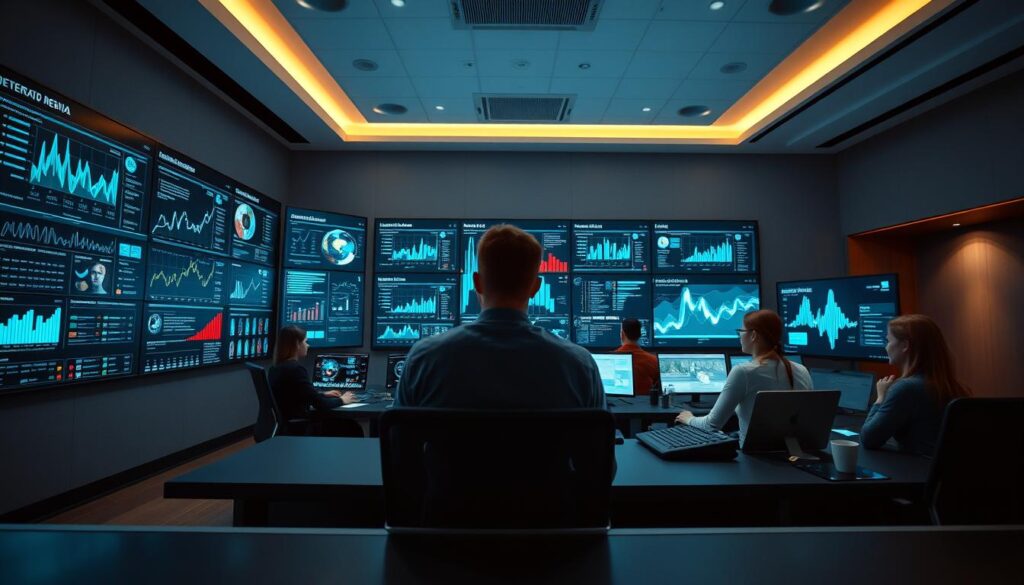
Data-driven strategies are reshaping how decisions are made in the media landscape. By leveraging advanced tools, companies can analyze vast datasets to uncover actionable insights. This approach ensures that decisions are not only faster but also more accurate19.
Real-Time Analytics and Feedback Loops
Real-time analytics enable organizations to adapt quickly to audience preferences and market trends. For example, Netflix uses machine learning to analyze viewing habits and optimize content recommendations19. This impact on user engagement is significant, with 28% of American customers discovering new shows through personalized suggestions19.
Feedback loops play a crucial role in refining strategies. By continuously analyzing data, companies can identify patterns and adjust their approaches. This generation of actionable insights ensures that content remains relevant and engaging20.
Enhanced Business Intelligence
Enhanced business intelligence tools provide a comprehensive view of operations. Predictive models and analytical dashboards allow companies to forecast trends and allocate resources effectively20. For instance, AI tools can prepare data for analysis in a fraction of the time compared to manual processes20.
These tools also improve data quality by automatically spotting and fixing errors. This ensures that teams can focus on strategic decisions rather than data cleanup20. The impact of these advancements is clear: businesses can operate more efficiently and deliver better results.
By integrating these technologies, media companies are transforming their decision-making processes. The ability to generate real-time insights and adapt quickly is driving innovation and success across the industry21.
Real-World Examples of AI in Entertainment
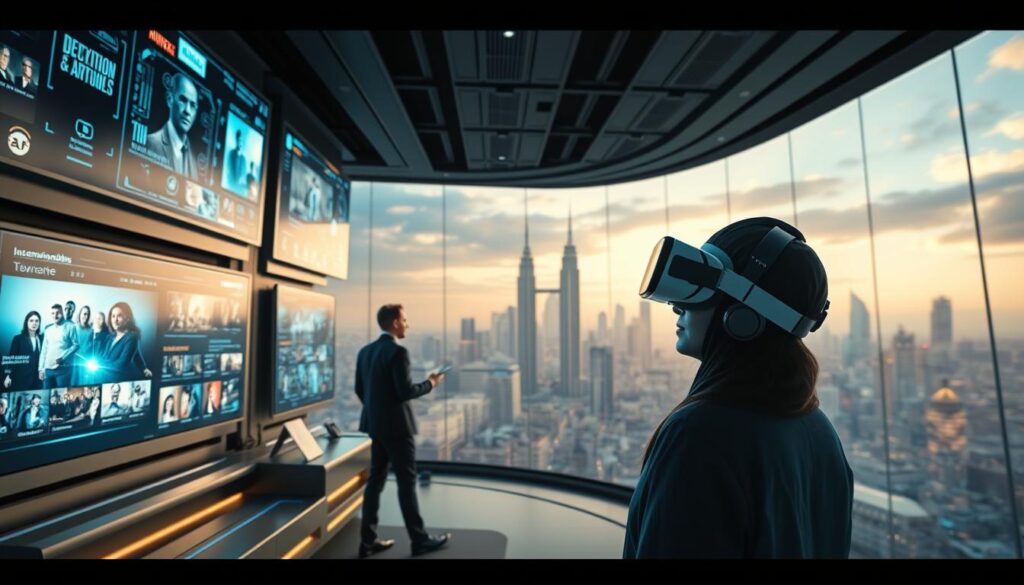
Streaming services are leveraging advanced technologies to redefine viewer experiences. These platforms use intelligent systems to analyze user behavior and deliver tailored content. This approach not only enhances satisfaction but also drives engagement and loyalty22.
Streaming Platforms and Personalized Recommendations
Personalized recommendations are a cornerstone of modern streaming. Platforms like Netflix employ deep learning techniques to analyze viewing habits and suggest relevant content22. This task is critical for retaining users, with 28% of American customers discovering new shows through these suggestions22.
Amazon Prime also uses intelligent systems to enhance its voice-controlled experience. By automating repetitive tasks, the platform ensures seamless navigation and faster content discovery23. These innovations highlight the role of technology in shaping viewer preferences.
Case Studies from Netflix and Amazon Prime
Netflix’s recommendation engine is a prime example of intelligent systems in action. It uses collaborative filtering to predict user preferences, boosting retention rates significantly22. This continuous learning process ensures that recommendations remain relevant and engaging.
Amazon Prime’s voice-controlled interface showcases the power of automation. By simplifying navigation, it reduces the effort required to find content23. These case studies demonstrate how intelligent systems are transforming the role of streaming platforms in the entertainment industry.
These real-world examples underscore the importance of data-driven solutions. By automating routine tasks and leveraging continuous learning, platforms like Netflix and Amazon Prime are setting new standards for viewer satisfaction22.
Corporate Success Stories and AI Partnerships in Media

Strategic collaborations are reshaping the media landscape through innovative solutions. Companies are partnering with tech innovators to unlock new dimensions in content creation and customer engagement. These alliances are driving significant transformations, boosting operational efficiency, and enhancing creative workflows.
Prismetric’s AI Development Services
Prismetric has emerged as a leader in tailored AI development services. Their capability to design intelligent systems has enabled media companies to streamline production processes and improve audience targeting. For instance, their solutions have helped clients achieve a 30% increase in code generation, saving thousands of hours annually24.
By leveraging advanced tools, Prismetric empowers developers to focus on creative tasks while automating repetitive work. This approach not only reduces costs but also accelerates time-to-market for new content25.
Enterprise Solutions by LeewayHertz
LeewayHertz delivers robust enterprise solutions that demonstrate their capability to handle complex media challenges. Their platforms are designed to enhance operational efficiency and scalability. For example, their AI-driven tools have helped organizations save up to 2,200 hours monthly by automating routine tasks24.
Their developer-focused approach ensures that businesses can adapt to evolving demands. By integrating intelligent systems, LeewayHertz enables companies to optimize their workflows and deliver exceptional results26.
These success stories highlight the transformative impact of strategic partnerships. By combining expertise and technology, companies are setting new benchmarks in the media industry.
Ethical Considerations and Challenges in AI Integration

As technology advances, ethical concerns surrounding its integration into media and entertainment are becoming increasingly critical. The rapid adoption of intelligent systems has brought both opportunities and challenges, particularly in ensuring content authenticity and responsible implementation.
Deepfake Detection and Content Authenticity
One of the most pressing issues is the rise of deepfake technology. These manipulated videos and images can spread misinformation, posing risks to political stability and public trust27. Robust detection systems are essential to identify and mitigate such threats, ensuring that content remains authentic and reliable.
For instance, the ACLU’s experiment revealed a 25% misidentification rate in facial recognition software, highlighting the need for improved accuracy28. Without effective safeguards, the misuse of these tools could lead to significant societal harm.
Responsible AI Practices
Implementing responsible practices is equally important. The White House has invested $140 million to address ethical challenges, emphasizing the need for transparency and accountability27. This includes ensuring that systems are free from bias and that their decision-making processes are interpretable.
Ethical frameworks also call for safeguarding intellectual property and user data. As automation streamlines production processes, it’s crucial to balance efficiency with ethical oversight28. Transparent guidelines and frameworks can help manage these technologies responsibly, fostering trust among users and creators alike.
Exploring The Future of AI Agents in Entertainment and Media

Innovative technologies are reshaping how stories are told and experienced, pushing creative boundaries like never before. From gaming to film production, these advancements are transforming the industry, offering new possibilities for creators and audiences alike.
Emerging Trends and Innovations
One of the most exciting trends is the use of autonomous agents in gaming. These systems enable non-player characters (NPCs) to remember player choices and adapt their behavior accordingly, creating more immersive experiences29. For example, in games like Minecraft, companions learn from player actions, suggesting architectural ideas based on individual styles29.
Film production is also benefiting from these advancements. Wētā FX’s proprietary software, Massive, created digital hordes with individual agents capable of decision-making, enhancing the realism of battle scenes in “The Lord of the Rings: The Two Towers”29. This innovation allows for nuanced character animations, including detailed facial expressions and body language, without constant animator input29.
Scalability and Evolution of AI Tools
As these tools evolve, they are becoming more scalable, meeting sophisticated creative and business demands. Platforms like SmythOS provide developers with tools to manage and monitor deployment, ensuring alignment with creative visions and user expectations29. This way of working combines human creativity with machine precision, driving unprecedented changes within the sector.
Streaming services are another example of this evolution. They analyze past viewing habits to provide personalized content recommendations, enhancing viewer experience29. This innovation not only improves satisfaction but also boosts engagement and loyalty.
“The integration of autonomous agents is revolutionizing how we create and consume media, offering endless possibilities for the future.”
For more insights on how human and AI collaboration is shaping the industry, explore our detailed guide.
Enhancing Production Efficiency and Operational Excellence
Production processes are evolving rapidly with the integration of advanced technologies. These innovations are driving significant improvements in efficiency and cost-effectiveness. By leveraging ai-driven tools, companies can streamline workflows and achieve operational excellence.
Time and Cost Savings through Automation
Automation is a game-changer for reducing production time and lowering operational costs. Ai-driven systems can handle repetitive tasks, freeing up human resources for more creative endeavors. For instance, Comcast’s machine learning system has a 90% success rate in predicting technician visits, saving time and resources30.
Predictive maintenance through automation can reduce costs by 10-30% and increase equipment uptime by 5-15%31. These levels of efficiency are transforming how media companies operate, ensuring faster delivery of high-quality content.
Optimizing Production Workflows
Workflow optimization is another key benefit of ai-driven tools. Platforms like Warner Bros.’ Cinelytic use predictive analytics to guide film distribution decisions, improving efficiency30. This approach ensures that resources are allocated effectively, reducing waste and enhancing productivity.
Upskilling teams to work alongside intelligent systems is crucial. Workforce training programs can increase employee productivity by 10-20%31. By combining human skills with machine precision, companies can achieve unparalleled operational excellence.
Real-world examples, such as Disney+’s use of automation to filter content based on regional regulations, highlight the practical benefits of these technologies30. These innovations are setting new standards for efficiency and quality in the media industry.
The Role of Augmented Intelligence in Transforming the Workforce
The integration of augmented intelligence is reshaping how businesses operate, blending human creativity with machine efficiency. This transformative approach is redefining traditional roles and creating new opportunities for innovation. By combining human expertise with advanced software, organizations are achieving unprecedented levels of productivity and adaptability.
Hybrid AI-Human Collaboration
Hybrid collaboration models are at the forefront of this evolution. These models leverage augmented intelligence to handle repetitive tasks, allowing employees to focus on strategic initiatives. For example, enterprise systems now automate data entry and generate personalized email responses, freeing up valuable time for creative problem-solving32.
In sectors like finance, AI-driven risk assessment ensures accurate credit scoring, while in legal services, automation tools detect compliance violations33. This synergy between humans and machines is not just enhancing efficiency but also fostering innovation across industries.
Redefining Roles and Skill Sets
As augmented intelligence becomes more prevalent, traditional job roles are evolving. New positions like AI Trainers and AI Operations Managers are emerging, requiring skills in data literacy and cybersecurity34. This shift emphasizes the importance of lifelong learning to adapt to the future of work.
Organizations are also investing in upskilling programs to prepare their workforce for these changes. By equipping employees with the necessary skills, businesses can remain competitive in an AI-enhanced landscape33.
“Augmented intelligence is not about replacing humans but empowering them to achieve more.”
This approach ensures that businesses can scale effectively, adapt to fluctuating demands, and maintain a competitive edge in the digital age.
Conclusion
Decision-making processes are being revolutionized by advanced tools that enhance efficiency and accuracy. These technologies are transforming how industries operate, from production to customer service, ensuring better outcomes35.
Data-driven analytics are at the core of this shift. By analyzing vast datasets, companies can make informed decisions that improve operational efficiency and audience engagement36. This approach not only saves time but also maximizes resources.
Industry leaders must embrace these innovations to stay competitive. Investing in intelligent systems ensures scalability and adaptability in a rapidly changing landscape. The integration of human oversight with machine precision will drive future success.
FAQ
How is AI transforming content creation in the entertainment industry?
What role does AI play in personalized viewer experiences?
Can AI improve gaming experiences?
How does AI optimize marketing strategies in media?
What are the ethical concerns with AI in entertainment?
How does AI enhance production workflows?
What are some real-world examples of AI in media?
How is AI shaping the future of music composition?
What is the role of AI in business intelligence for media companies?
How does AI foster collaboration between humans and machines?
Source Links
- How AI is Shaping Media & Entertainment in 2025
- Human-AI Synergy in Media & Entertainment: The Next Frontier of Personalization
- AI in media and entertainment: Use cases, benefits and solution
- The Role of AI in Entertainment and Media Industry
- The Impact of AI in Entertainment and Media Industry
- The impact of AI in Entertainment & Media | TalentDesk
- How AI Image Processing APIs Are Transforming Content Creation in the Entertainment Industry
- AI in Media Industry: Artificial Intelligence and Latest Technology – Verbit
- AI in the Entertainment Industry: A Glimpse into the Future of Film and TV
- Orchestrating The Future—AI In The Music Industry
- Revolutionizing Media and Entertainment with AI
- Seven West Media: Pioneering the Future of Personalized Digital Engagement
- What is AI-driven Personalization? | NICE
- AI Agents in Gaming and E-Learning: Revolutionizing Experiences
- Agents of Change: The AI Saga Revolutionizing Gaming Worlds
- The Future of AI in Game Development | TalentDesk
- AI Marketing Campaigns: The Future of Advertising in 2024
- How AI Transforms Media and Entertainment Industry
- AI in Media and Entertainment – Use Cases and Examples – Parangat Technologies
- How AI Will Transform Data Analysis in 2025
- AI in Entertainment: Use Cases, Benefits, & Industry Impact
- AI in Media and Entertainment: Use cases, Benefits, Future and solution
- How real-world businesses are transforming with AI – with 50 new stories – The Official Microsoft Blog
- The ROI of Data Analytics and AI Training: Success Stories from Media Companies – Data Society
- Reshaping the media and entertainment landscape: gen AI takes centre stage
- The Ethical Considerations of Artificial Intelligence | Capitol Technology University
- AI Ethics : The Ethical Landscape of Artificial Intelligence
- SmythOS – The Role of Autonomous Agents in Entertainment: AI-Driven Engagement and Creativity
- AI in Media: Paving the Way for Next-Gen Media Platforms
- AI Agents for Manufacturing Success
- AI Agents in Enterprise: How Will They Change the Way We Work?
- Artificial Intelligence in the Workforce: Strategies to Address in 2025
- Autonomous AI Agents and the Future of Work
- Understanding The Role Of AI In Media and Entertainment
- What Is the Role of AI in the Entertainment Industry? – Webisoft Blog







